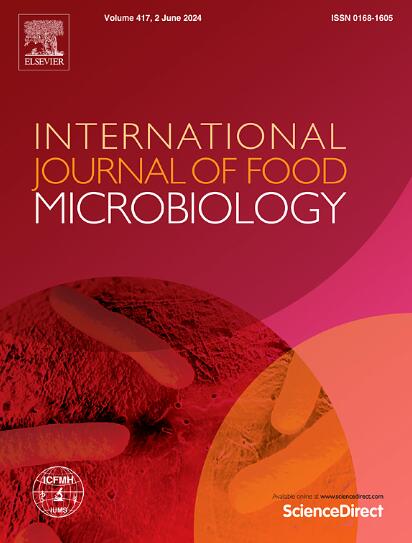Impact of intervention strategies on listeriosis risk in cooked ham: Biopreservation and high pressure processing
IF 5
1区 农林科学
Q1 FOOD SCIENCE & TECHNOLOGY
International journal of food microbiology
Pub Date : 2025-03-24
DOI:10.1016/j.ijfoodmicro.2025.111174
引用次数: 0
Abstract
Biopreservation and post-lethality treatments (PLT) are the basis of operating procedures applied to reduce the levels of Listeria monocytogenes in ready-to-eat food. The combination of these strategies must be wisely selected, and their interaction should be considered in quantitative microbial risk assessments (QMRA) assessing the listeriosis risk. The aim of the present study was to develop a QMRA model to assess the impact of intervention strategies, including formulation with lactate, bioprotective cultures and the use of high-pressure processing (HPP), on reducing the listeriosis risk associated to the consumption of cooked meat products by elderly populations. Particularly, the interaction between the formulation with lactate and the application of HPP was addressed as lactate is reported to exert (i) a piezo-protection on L. monocytogenes inactivation by HPP and (ii) a piezo-stimulation effect on the growth rate of survivors. Results showed that the reduction of product's shelf-life or the use of biopreservation strategies (lactate and bioprotective cultures) were more effective in reducing the listeriosis risk than mild HPP treatments. Moreover, the application of a mild HPP treatment in combination with the formulation with lactate did not result in a higher risk reduction compared to the formulation of lactate alone. On the other hand, the application of a 5-log PLT was more effective for risk reduction compared to other strategies. The results provided in this work can help in the design of measures to control L. monocytogenes that have the desired impact on risk of reduction.
干预策略对熟火腿李斯特菌病风险的影响:生物保存和高压处理
生物保存和致死后处理(PLT)是用于降低即食食品中单核细胞增生李斯特菌水平的操作程序的基础。必须明智地选择这些策略的组合,并在评估李斯特菌病风险的定量微生物风险评估(QMRA)中考虑它们的相互作用。本研究的目的是建立一个QMRA模型来评估干预策略的影响,包括乳酸制剂、生物保护性培养和高压处理(HPP)的使用,以减少与老年人食用熟肉产品相关的李斯特菌病风险。特别地,乳酸制剂与HPP的应用之间的相互作用得到了解决,因为据报道乳酸对HPP对单核细胞增生乳杆菌的失活具有(i)压电保护作用,(ii)对幸存者的生长速率具有压电刺激作用。结果表明,缩短产品保质期或使用生物保存策略(乳酸和生物保护性培养物)比轻度HPP处理更有效地降低李斯特菌病的风险。此外,与单独使用乳酸制剂相比,轻度HPP治疗与乳酸制剂联合应用并没有导致更高的风险降低。另一方面,与其他策略相比,应用5对数PLT对降低风险更有效。本工作提供的结果可以帮助设计控制单核增生乳杆菌的措施,对降低风险有预期的影响。
本文章由计算机程序翻译,如有差异,请以英文原文为准。
求助全文
约1分钟内获得全文
求助全文
来源期刊
CiteScore
10.40
自引率
5.60%
发文量
322
审稿时长
65 days
期刊介绍:
The International Journal of Food Microbiology publishes papers dealing with all aspects of food microbiology. Articles must present information that is novel, has high impact and interest, and is of high scientific quality. They should provide scientific or technological advancement in the specific field of interest of the journal and enhance its strong international reputation. Preliminary or confirmatory results as well as contributions not strictly related to food microbiology will not be considered for publication.

 求助内容:
求助内容: 应助结果提醒方式:
应助结果提醒方式:


